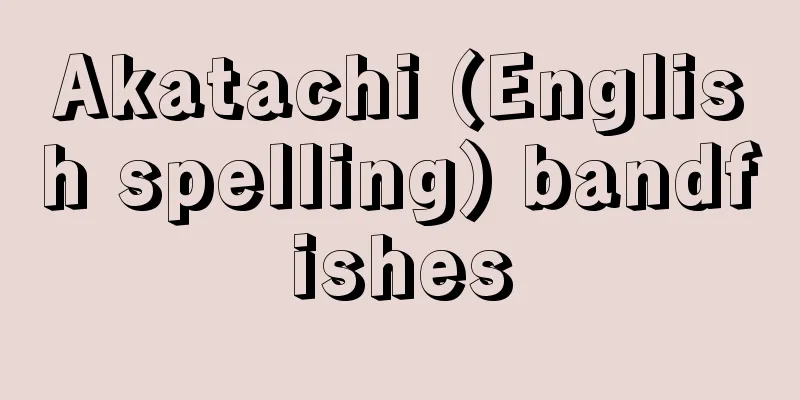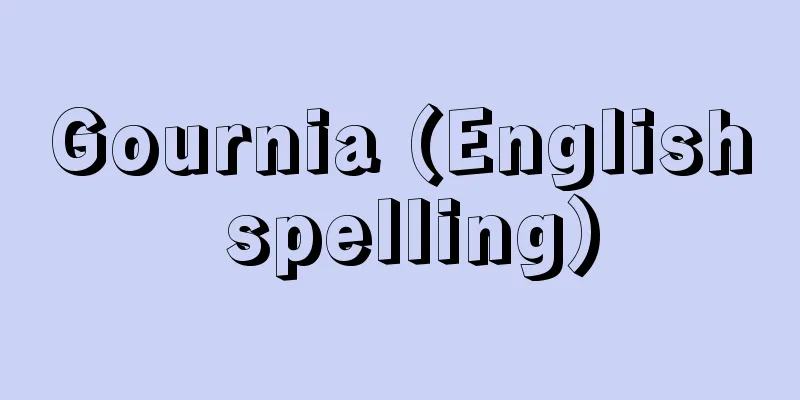Akatachi (English spelling) bandfishes

|
A general term for marine fishes belonging to the family Cepolinae in the order Perciformes of the class Osteichthyes, or one of these. Cepolinae fish have a continuous dorsal fin, and either no spines on the dorsal and anal fins or only three spines on the dorsal fin and one spine on the anal fin. This family is clearly divided into the subfamily Cepolinae, whose bodies are elongated and band-like, pointed at the rear end, do not have spines on the dorsal and anal fins, and are connected to the caudal fin, and the subfamily Owstoniinae, whose bodies are not band-like, have spines on the dorsal and anal fins, and are not connected to the caudal fin. Four species of the Acanthocepola subfamily are known from Japan: C. schlegelii , A. krusensternii , A. indica , and A. limbata . The subfamily Pseudocephalinae includes P. taeniosoma , O. totomiensis, O. japonica, and O. totomiensis. However, some researchers do not recognize these subfamilies. Nineteen species from four genera are known from around the world, from the western Pacific, Indian Ocean, and eastern Atlantic Ocean. It lives in holes in the sandy, muddy bottom at depths of 50 to 200 meters, waiting with about half of its body sticking out of the hole, then sticking its entire body out and treading water to catch food. [Masao Katayama and Kunio Amano, February 17, 2021] Representative speciesAcanthocepola krusensternii (red-spotted bandfish) is found in the Pacific Ocean from Sagami Bay, and in the Sea of Japan from Niigata Prefecture to the southern coast of Kyushu, the East China Sea, Taiwan, the Chinese coast such as Guangdong Province, the Philippines, Flores Island, and other parts of the Western Pacific and Indian Oceans. The body is laterally compressed, and the rear is elongated in a band-like shape, gradually tapering toward the rear and becoming pointed at the rear end. The body length is 8 to 11 times the body height. There are 3 to 5 spines on the lower edge of the preopercular bone. The mouth is upward-facing, and the rear end of the upper jaw extends slightly beyond the center of the eye. The upper and lower jaws have a single row of teeth that curve slightly inward. The vomer (the bone at the front end of the skull base) and the palate are toothless. The scales are small. The dorsal fin starts above the gill slits, the anal fin starts below the 10th dorsal ray, goes backwards and continues to the tail fin. The dorsal fin has 78-85 soft rays, the anal fin has 76-82 soft rays, and the pectoral fin has 18-19 soft rays. The body is orange-red with a row of pale yellow circular spots on the sides. The edges of the vertical fins are yellowish. They live in holes they dig in sand, coarse sand, or sandy mud bottoms at depths of 50-140 meters, and tread water around them to feed. They mainly eat small shrimps, crabs, and small fish. They spawn from June to September. Mature eggs are about 0.7 mm in diameter and contain one oil globule. Larvae, 1.7 mm in length, have a long, slender body and spines on the edge of the preopercle. Larvae, 4.7 to 8.0 mm in length, have a large head and large spines on the edge of the preopercle and on the top of the head, which is completely different from the body shape of adults. When the larvae reach a total length of about 14 mm, the spines begin to retract and the body begins to elongate. Adult fish are caught as by-catch in bottom trawl nets, but the quantity is small. The flesh is white and is used in prepared dishes and as an ingredient in fish paste products. Similar species include the Ittenakatachi, which has a black spot on the front of its dorsal fin, the Indoakatachi, which has a tall body, and the Sumitsukiakatachi, which has a black spot on its upper jaw. [Masao Katayama and Kunio Amano, February 17, 2021] [Reference item] | |Source: Shogakukan Encyclopedia Nipponica About Encyclopedia Nipponica Information | Legend |
|
硬骨魚綱スズキ目アカタチ科に属する海水魚の総称、またはそのなかの1種。アカタチ科は背びれが一続きで、背びれと臀(しり)びれに棘(きょく)がないか、あっても背びれに3棘と臀びれに1棘しかない。本科は、体が帯状で細長く伸長し、後端でとがり、背びれと臀びれは棘をもたず、尾びれと連続するアカタチ亜科Cepolinaeと、体は帯状でなく、背びれと臀びれに棘をもち、尾びれとつながらないソコアマダイ亜科Owstoniinaeに明瞭(めいりょう)に分かれる。 日本からアカタチ亜科にはスミツキアカタチ属CepolaのスミツキアカタチC. schlegelii、アカタチ属AcanthocepolaのアカタチA. krusensternii、インドアカタチA. indicaおよびイッテンアカタチA. limbataの4種が、そしてソコアマダイ亜科にはアカタチモドキ属PseudocepolaのアカタチモドキP. taeniosoma、ソコアマダイ属Owstoniaのオキアマダイ、オオソコアマダイ、ソコアマダイO. totomiensisおよびソコアマダイモドキO. japonicaの4種が知られている。しかしこれらの亜科を認めない研究者もいる。世界からは4属19種が西部太平洋、インド洋および東部大西洋の海域から知られている。水深50~200メートルの砂泥底の穴に生息し、穴から体の半分ほどを出して待機し、全身を出して立ち泳ぎして餌(えさ)をとる。 [片山正夫・尼岡邦夫 2021年2月17日] 代表種アカタチAcanthocepola krusensternii(英名はred-spotted bandfish)は太平洋側では相模(さがみ)湾から、日本海側では新潟県から九州南岸、東シナ海、台湾、広東(カントン)省など中国沿岸、フィリピン、フロレス島など西太平洋とインド洋に分布する。体は側扁(そくへん)し、後方は帯状で長く延長し、後方に向かってだんだんと細くなり、後端でとがる。体長は体高の8~11倍。前鰓蓋骨(ぜんさいがいこつ)の下縁に3~5本の棘がある。口は上向きで、上顎(じょうがく)の後端は目の中央部下をわずかに越える。上下両顎の歯は1列で、すこし内側に湾曲する。鋤骨(じょこつ)(頭蓋床の最前端にある骨)と口蓋骨に歯がない。鱗(うろこ)は小さい。背びれは鰓孔(さいこう)の上方から、臀びれは背びれ第10軟条下方から始まり後方に向かい、尾びれに連続する。背びれは78~85軟条、臀びれは76~82軟条、胸びれは18~19軟条。体色は橙赤(とうせき)色で側面に淡黄色の小円斑(えんはん)が1列に並ぶ。垂直鰭(すいちょくき)の縁辺は黄色みを帯びる。水深50~140メートルの砂、粗砂、砂泥底に穴を掘って生息し、その周辺で立ち泳ぎをして捕食する。おもに小形のエビ類、カニ類、小魚などを食べる。産卵期は6~9月ころ。熟卵の直径は0.7ミリメートルほどで、1個の油球をもつ。全長1.7ミリメートルの仔魚(しぎょ)では体が細長く、前鰓蓋骨の縁辺に棘をもつ。体長4.7~8.0ミリメートルの仔魚では頭が大きくなり、前鰓蓋骨の縁辺や頭頂部に大きな棘を有し、成魚の体形とまったく異なる。全長14ミリメートルほどになると棘が退縮し始め、体は伸長し始める。成魚は底引網で混獲されるが、量が少ない。肉は白身で、総菜用や練り製品の原料にされる。近似種に背びれ前部に黒斑があるイッテンアカタチ、体高が高いインドアカタチ、上顎に黒斑があるスミツキアカタチが知られている。 [片山正夫・尼岡邦夫 2021年2月17日] [参照項目] | |出典 小学館 日本大百科全書(ニッポニカ)日本大百科全書(ニッポニカ)について 情報 | 凡例 |
<<: Akatateha (English spelling) Indian red admiral
>>: Prefecture Inukai Yae - Agata Inukai No Yae
Recommend
Forestry Basic Law - Ringyo Kihonho
This law (Act No. 161 of 1964) was promulgated in...
"Illustrated Newspaper Japan" - Eshinbun Nipponchi
…From 1871 to 1880, he actively illustrated works...
Aristideides (English spelling)
Athenian politician and general, from about 520 to...
treasure-hunt
...A game in which a group of rabbits are followe...
Celebration of New Year - Ganoiwai
A celebration of longevity, also known as sanka. ...
Cameroon National Union
... The first president of this federation was Ah...
Stannoidite
…A mineral whose main component is tin. There are...
Ethylene Center
... In 1980, the Ministry of International Trade ...
Mr. Aihara
...There are various branches of samurai who were...
Kansei calendar
One of the Japanese calendars. It was compiled in...
Humanism
A translation of the English term humanism and the...
Urban Wind - Toshikaze
Winds unique to cities. There are two possible ca...
Moratorium (English spelling)
A government law that allows the government to sus...
Gasparo da Salò (English spelling)
… The early centers of violin making were Brescia...
Tamil - Tamil
A language belonging to the Dravidian language fam...









![Japan Industrial Bank [Stock] - Nihon Kangyōginko](/upload/images/67cc702ee4b76.webp)